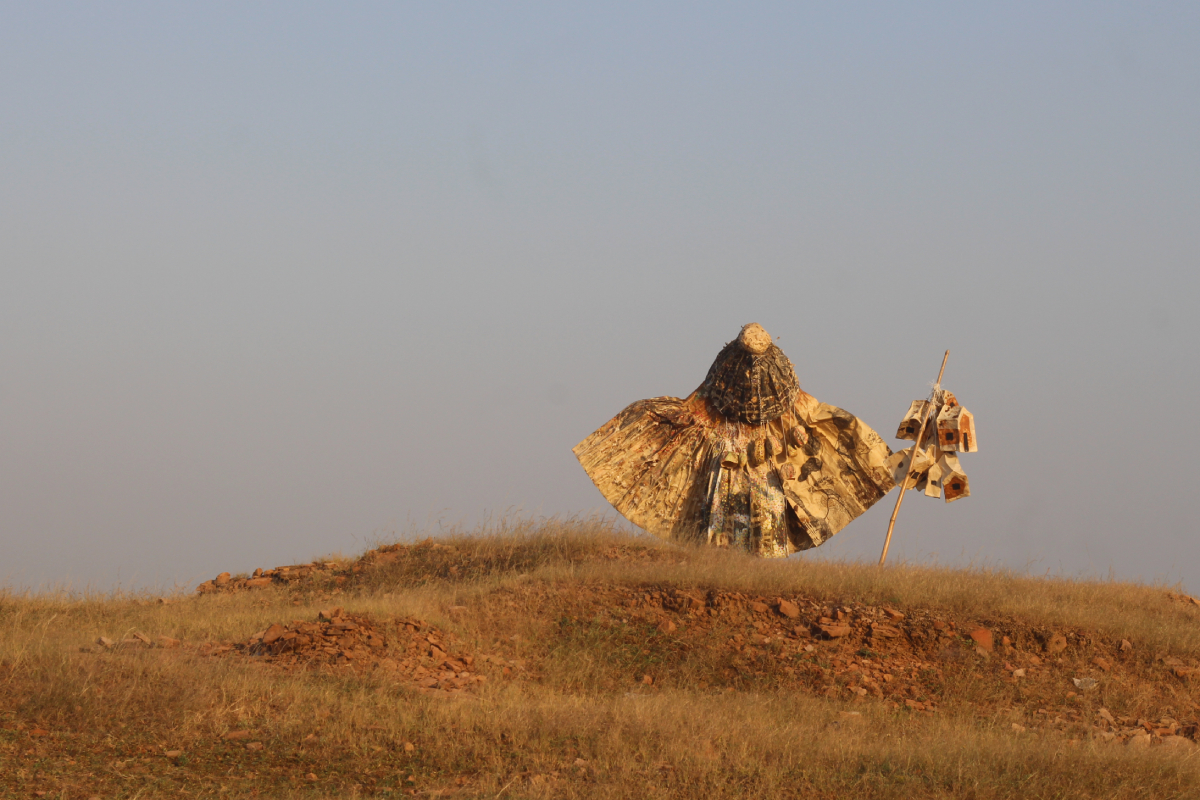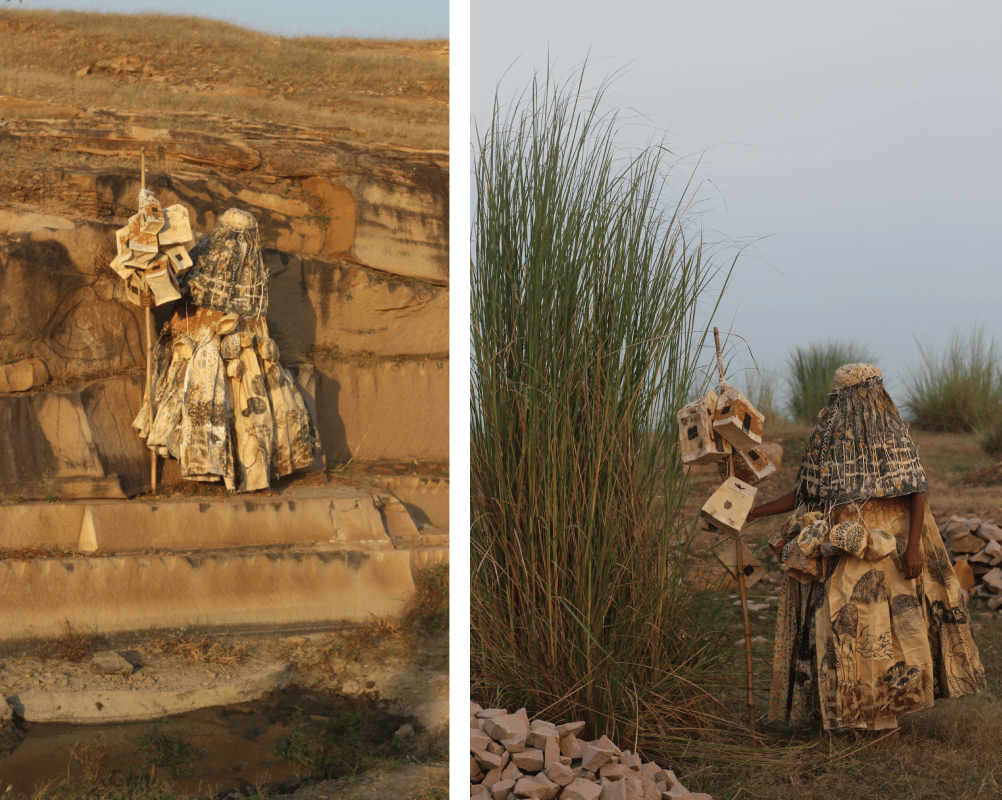Phantasmic 'Queerscapes': Performing Spatialities in Debashish Paul’s Body as a Landscape; Body in a Landscape
AUTHOR
Tony Jacob
Amidst a neglected panorama oblivious to the customs and travesties of domesticity, a desolate figure treads a barren terrain. Overhead, an imminent cloud of fog hangs, within arm’s reach, threatening to engulf the actors. Flanked by a waterbody, the scenery, despite its desolation, is animated by windswept vegetation and impassioned bird-song, evoking a terrestrial tango. This is Jārgo, an arid location about thirty miles from Varanasi, Uttar Pradesh, in northern India. For forty-five days, the figure serenades the landscape, traversing this expansive setting. Through this performance, the figure—barefoot, adorned with a stiff sculptural costume, a veiled headdress, and a wooden staff from which paper sculptures of houses hang, drumming against each other and the wind—contemplates their corporeal memories in relation to the untamed earth. They walk, stop, rest, perform ritualistic gesticulations, and scale the land through their treading. They collect objects and materials and draw references of local terrestrials onto their sculptural dress, evoking mountains, rivers, flowers, grass, and vegetation. This is Debashish Paul’s durational performance piece, Body as a Landscape; Body in a Landscape (2022)—a poetic reimagination of queerness. This practice (con)fabulates a limitless existence beyond the confines of the normative body, embracing a queer practice that confronts the invisibility of marginalised identities. It envisions a spatial redemption for gendered, sexualised, racialised, and othered bodies existing beyond the hegemonic socio-political realities of postcolonial India.

The figure’s transitory journey across the wretched landscape mirrors the condition of queer (in)visibility and the dejected search for spatial belonging—a struggle endemic to non-heterosexual bodies attempting to traverse the public spheres of contemporary India. In a phantasmic attempt at spatial reclamation, Paul foregrounds their corporeal bearing, to respond and react to the terrain and atmospheric conditions of Jārgo. Through their inhabitation of and interaction with the space––tending to local vegetation, adding items to their dress, and collecting objects, the figure and their space lay impressions on each other, carving out spatialities of bountiful and boundless queer acceptance, compassion, and tolerance. This centrality of the body through which Paul maps spatial formations echoes Maurice Merleau-Ponty’s phenomenological consideration that affirms: “spatial forms or distance are not relations between divergent points in objective space as they are relations between these points and a central perspective—our body”.[1] Sara Ahmed’s observation that landscapes leave textural ‘impressions’ on the affective body through air, smell, and sounds extends this consideration of the body’s phenomenology towards a reciprocal body-space coalescence. The emphasis is that spaces are not external to bodies but are “second skin that unfolds in the folds of the body”[2]. In the context of queer spatiality, sexuality determines spatial formation and is determined by ways of inhabiting space—a consideration which implies that queer bodies make and are made by their spaces.[3] This illustrates the integral nature of the landscape in Debashish Paul’s performance, showing how the queer body performs inhabitation: both of and by its spatialities.

In this fabulation of queer spaces, Paul’s performance draws upon corporeal recitations––by allowing the figure to dance, walk, breathe, and exist with(in) the landscape without the fear of obliteration. This movement within the brown-green terrain of the local landscape rebuffs the invisibilities brought on by the camouflage of normativity. By resisting bodily dissolution against the soft contours of Jārgo, Paul’s movement resurrects the queer body from static oblivion, thumping a temporal rhythm that enlivens a queer sensorial continuum. The necessity of ‘movement’ as integral to queer wellbeing can be gleaned from Eve Kosofsky Sedgwick’s approach to queerness as a “continuing moment, movement, motive” that is “recurrent, eddying, and troublant”; as an existence “across” genders, sexualities, genres, and “perversions”.[4] This synonymisation of ‘across’ as a mode of ‘queer movement’ within the context of Paul’s performance hints at a certain aesthesis of traversing and transposition—a modal fluxus of self-fashioning that proposes undulating shape-shifting landscapes as tropes for queer visualisation. This landscape, or ‘queerscape’, emblematic of queer memories, experiences, feelings, and sensations, is posited as a ‘contingent and tangential’ space that repurposes ‘public space’ to ‘disrupt what heterocentric ideology assumes to be an intimate, coherent relation between biological sex, gender, and sexual desire’[5]. The evocative quality of Paul’s ‘queerscape’, critiques the intolerance of public spaces, reckoning with the violence of heteronormativity, while gesturing towards nonviolent interstices for queer self-proclamation, declarations, and visibilities.
The implications of using queer fantasy to create convalescent, phantasmic queer spatialities within public spaces lie in its scope to re-create non-normative histories from absences or non-visibilities. This imagination, as seen in Debashish Paul’s performance practice that relies on the fantastical or magical, necessitates archival operations that demand creative and critical approaches to access. This non-bureaucratic archival conceptualisation rallies the intimate, the personal, and the emotional as powerful inventorial forces that promulgate queer visibilities. Establishing such an ‘archive of feeling’ calls for affective interventions that necessitate transposition, absorption, and effective engagement with non-normative sensations and solidarities.[6] This interaction with the queer archive, collected from the quotidian, calls for a queering of the senses or a deliberate de-centring of the visual phenomenon of anteriority: the archive leaves ‘impressions’ through air, smell, and sound. This ‘queerscape’ enacts the ‘materiality’ of the queer archive, becoming a moment where embodied sensorialities of queer bodies come together to make a collective public reformation.[7] Through their redemption of queer histories, which struggle to be recollected within the mechanisms of our collective postcolonial condition, the artist’s performance reminds us of the phantasmagoric potential to conjure magical ‘queerscapes’ within the recesses and hollows of our limitless bodies.
Except from Body as a Landscape; Body in a Landscape, 2022. Video Credit: Saurabh Singh.
References
Ahmed, Sara. 2006. Queer Phenomenology: Orientations, Objects, Others. Durham: Duke University Press. https://doi.org/10.2307/j.ctv125jk6w.
Betsky, Aaron. 1997. Queer Space: Architecture and Same-Sex Desire. First edition. New York: William Morrow and Company, Inc.
Cvetkovich, Ann. 2003. An Archive of Feelings: Trauma, Sexuality, and Lesbian Public Cultures. Durham, NC: Duke University Press (Series Q).
Mayer, Sophie. 2015. “Uncommon Sensuality: New Queer Feminist Film/Theory.” In Feminisms, edited by Laura Mulvey and Anna Backman Rogers, 86–96. Amsterdam: Amsterdam University Press (Diversity, Difference and Multiplicity in Contemporary Film Cultures).
Mbembe, Achille. 2002. “The Power of the Archive and its Limits.” In Refiguring the Archive, edited by Carolyn Hamilton et al., 19–27. Dordrecht: Springer Netherlands.
Merleau-Ponty, Maurice. 2002. Phenomenology of Perception. 2nd ed. London: Routledge. https://doi.org/10.4324/9780203994610.
Sedgwick, Eve Kosofsky. 1993. Tendencies. Durham: Duke University Press.
Notes
[1] Maurice Merleau-Ponty, Phenomenology of Perception, 2nd ed (London: Routledge, 2002), 5. https://doi.org/10.4324/9780203994610
[2] Sara Ahmed, Queer Phenomenology: Orientations, Objects, Others (Durham: Duke University Press, 2006), 0. https://doi.org/10.2307/j.ctv125jk6w.
[3] Aaron Betsky, Queer Space: Architecture and Same-Sex Desire (New York: William Morrow and Company, Inc., 1997), 67.
[4] Eve Kosofsky Sedgwick, Tendencies (Durham: Duke University Press, 1993).
[5] Sophie Mayer, “Uncommon Sensuality: New Queer Feminist Film/Theory,” in Feminisms, ed. Laura Mulvey and Anna Backman Rogers (Amsterdam: Amsterdam University Press, 2015), 86–96.
[6] Ann Cvetkovich, An Archive of Feelings: Trauma, Sexuality, and Lesbian Public Cultures (Durham, NC: Duke University Press, 2003).
[7] Achille Mbembe, “The Power of the Archive and Its Limits,” in Refiguring the Archive, ed. Carolyn Hamilton et al. (Dordrecht: Springer Netherlands, 2002), 19–27.
About the Author
Tony Jacob is a writer, researcher, and creative practitioner from Kerala, India. His research interests include politics of censorship, (non-)erasure as epistemic and aesthetic practice, representations of spatialities, and poetics of care within modern art and contemporary artistic practices. He holds an MA in Contemporary Art Practice from the Royal College of Art, London, and is the founder and organiser of an interdisciplinary artistic research forum Critical Symposium.

